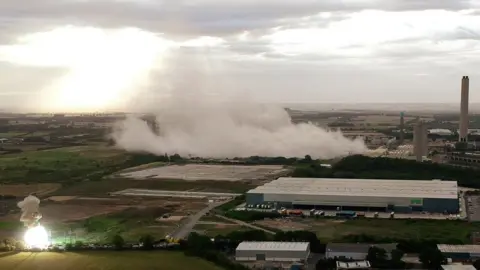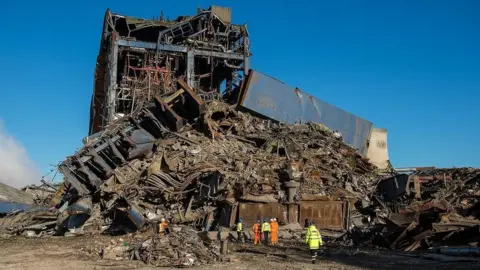Didcot power station: Power cut as cooling towers demolished
Thousands of households lost electricity moments after a disused power station's remaining cooling towers were demolished.
Didcot A's 375ft (114.3m) high towers were brought down using explosive charges at 07:00 BST.
Moments later, witnesses said, a nearby electricity pole went up in flames.
Scottish and Southern Electricity Networks (SSEN) said material related to the demolition had struck overhead power lines.
Up to 49,000 homes were without power until it was restored by 08:20.
Crowds who had gathered early to watch the controlled blast said the pole - connected to an overhead power line - caught fire "within 10 seconds" of the detonation.
One witness said the blaze "started with a bit of smoke, then a huge bright blue light and lots of noise before turning bright orange".
 @mypifi
@mypifiSSEN said engineers were alerted to a fault in the Sutton Courtenay area, where the power station is, at 07:04.
There were multiple reports of households suddenly losing electricity.
Allow X content?
While those who went to watch the demolition said the explosion had appeared to affect electrical cables in the surrounding area.
Allow X content?

A spokesman for SSEN said: "During the demolition, a large section of debris protection material became detached from one of the cooling towers and made contact with our 33kV overhead line, which was outside of the advised perimeter. This resulted in significant damage to the overhead line and subsequent network faults.
"We are in contact with the station owner, RWE, to support them in their incident investigation alongside our own internal review into the network fault.
"SSEN takes its responsibility to public safety seriously. We are aware of reports of minor injuries and damage caused by the incident at Sutton Courtenay and are working with the police and other agencies to identify those impacted."
An exclusion zone was set up around the site of the former coal-fired power station, which was turned off in 2013 after 43 years in service.
Site owners RWE Power had warned onlookers not to attempt to view the demolition from close quarters.
The fall of the station's northern towers came after the three southern towers were demolished in 2014.
RWE Power, which owns the site, said it had planned the demolition over several months with its contractor Brown and Mason and relevant local authorities.
You may also be interested in:
 PA Media
PA MediaDidcot A was commissioned in 1964 by the Central Electricity Generating Board (CEGB) before it was connected to the national grid in 1970.
The town's railway line and proximity to the Thames also meant the location was right for the tonnes of coal and gallons of water the power station would require.
The 2,000 megawatt (MW) station operated until 2013, when RWE Power move to decommission it when new EU reduced emissions rules were brought in.
Owners RWE Npower had planned to clear the site by the end of 2017, but its plans were delayed when the site's boiler house collapsed, killing four workers.
Ken Cresswell, 57, John Shaw, 61, Michael Collings, 53, and Christopher Huxtable, 34, died in the major incident in February 2016.
It took more than six months for the four men's bodies to be recovered, prompting criticism from their families.
The power station's 655ft (199.5m) chimney - one of the tallest structures in the UK - will be demolished in the autumn.
Didcot Power Station timeline
 Thames Valley Police
Thames Valley Police1964 - Building starts
1970 - Didcot A begins commercial operation
1994 - Construction starts on Didcot B, a gas fired station
1997 - Didcot B begins commercial operation
2003 - Voted Britain's third worst eyesore
2009 - Protestors climb chimney and stay there for two days
March 2013 - Didcot A closed
July 2014 - Three of its cooling towers are demolished
February 2016 - A major incident is declared after the boiler house collapses, and the body of worker Michael Collings is found
July 2016 - The remaining section of the boiler house is brought down using explosives
September 2016 - The bodies of Ken Cresswell, John Shaw, and Christopher Huxtable are recovered
December 2017 - An evidence file is passed to the Crown Prosecution Service by police
January 2018 - Thames Valley Police reveals it is considering manslaughter and gross negligence charges
